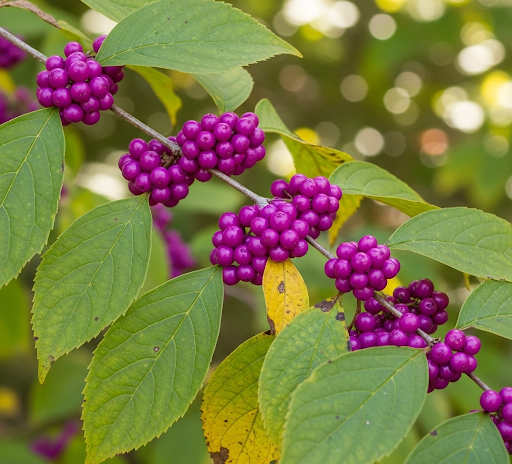American Beautyberry Seeds
American Beautyberry Seeds
Couldn't load pickup availability
American Beautyberry
(Callicarpa americana)
Callicarpa americana, or American beautyberry, is a deciduous shrub native to the southeastern United States, as well as parts of Mexico and the Caribbean. It is most famous for its striking clusters of bright purple berries that form tightly around the stems in late summer and fall, creating a vivid contrast against its green foliage.
The shrub typically grows between three and eight feet tall and can spread nearly as wide, with an open, arching growth habit that gives it a graceful appearance in the landscape. Its leaves are opposite, oval-shaped, and slightly toothed, releasing a mild aroma when crushed.
Small, pink to lavender flowers appear in late spring to early summer, attracting pollinators such as bees and butterflies. The berries provide a valuable food source for birds, deer, and other wildlife through the fall and into winter, and have been traditionally used in jellies and preserves.
American beautyberry grows well in full sun to partial shade, adapts to a variety of soil types, and tolerates drought once established. It is also known for its natural insect-repelling properties, as crushed leaves can help deter mosquitoes. Combining showy seasonal color with ecological benefits, it is a favored choice for native and wildlife-friendly gardens.
Zones: 6 to 10
Germination Range: 60-80%
Stratification Requirement: Seed requires 90 days cold moist stratification
Planting Instructions:
1. Cold stratification
American beautyberry seeds germinate best after a period of cold, moist treatment that mimics winter. Place the clean seeds in a small bag with seed-starting mix, peat moss, or vermiculite, seal it, and refrigerate at about 40°F (4°C) for 60 to 90 days.
2. Planting time
After stratification, plant seeds in late winter to early spring, either indoors in pots or directly outdoors if frost danger has passed.
3. Soil and location
Use a well-drained, loamy or sandy soil. Beautyberry is tolerant of poor soils but prefers slightly acidic to neutral pH. Outdoors, pick a spot with full sun to partial shade.
4. Planting depth
Sow seeds about 1/8 inch (3 mm) deep, lightly covering them with soil.
5. Watering
Keep the soil consistently moist but not soggy. Germination can be slow—sometimes 2 to 3 months.
6. Transplanting
Once seedlings are several inches tall and have a few sets of true leaves, transplant them to their permanent spot, spacing them about 3–5 feet apart.
Share


